
The Solar-Terrestrial Centre of Excellence (STCE) is a collaborative network of the Belgian Institute for Space Aeronomy, the Royal Observatory of Belgium and the Royal Meteorological Institute of Belgium.
 |
Published by the STCE - this issue : 20 Apr 2012. The Solar-Terrestrial Centre of Excellence (STCE) is a collaborative network of the Belgian Institute for Space Aeronomy, the Royal Observatory of Belgium and the Royal Meteorological Institute of Belgium. |
| Archive of the newsletters | Subscribe to this newsletter by mail |
A few STCE members got the opportunity to visit the European Astronaut Centre in Cologne, Germany. Astronauts are selected, trained, get medical support and surveillance in this centre. Some impressions:
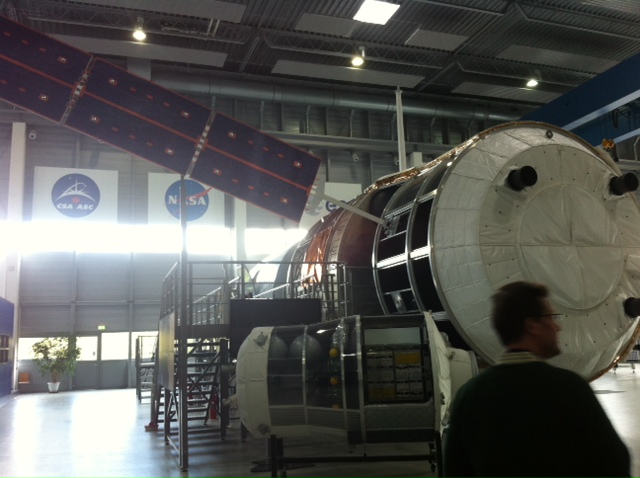

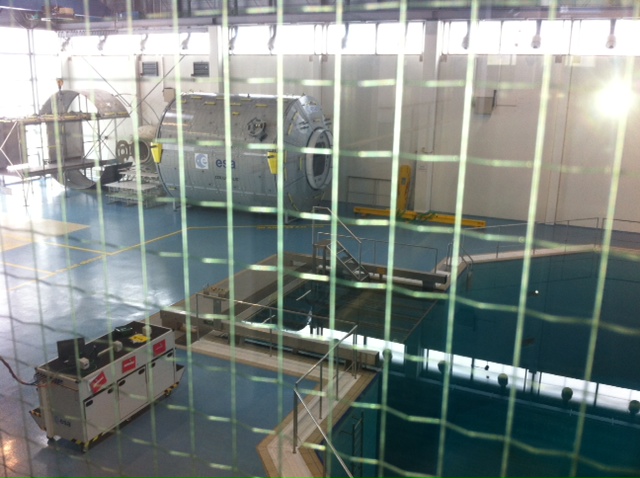
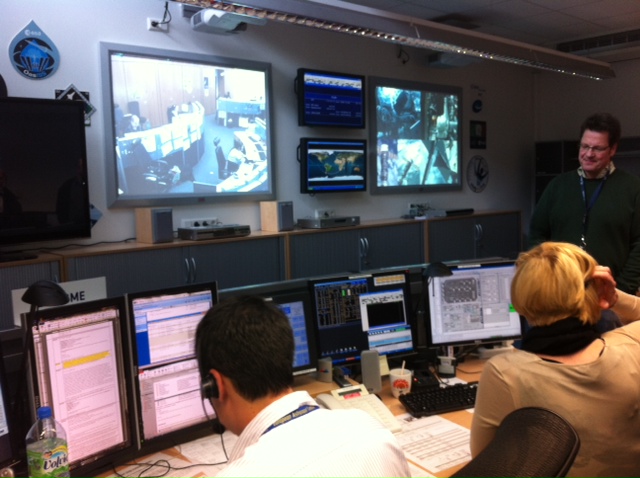
In the framework of the STCE-2012 annual meeting, we organize the STCE-2012 Alfven workshop on Alfven waves and turbulence in solar-terrestrial plasmas'. The main goal of this workshop is to review the last year achievements and coordinate research developed by the STCE institutes within Space Pole and in collaboration with outside partners. In this year edition of the workshop we appreciate the fact that Alfven waves as observed in space plasmas are mostly in a turbulent state, hence turbulence is now explicitly included in the workshop title. Another new thing is that the workshop will be in two parts. The first (morning) part will have the same format as last year, consisting of regular (20+5)-min talks. The second (afternoon) part will be a joint workshop/STCE seminar given by two world-class scientists in the field.
The workshop will be held on May 25, 2012 in the Meridian Room of ROB. The preliminary workshop program is as follows:
Part I. STCE-2012 Alfven workshop
09:40 - Welcome drinks, tea/coffee
09:50 - Welcome foreword (Y. Voitenko, BISA, Belgium)
10:00 - Reduced MHD turbulence, homogeneous case and applications to loops and coronal holes (A. Verdini, ROB, Belgium)
10:25 - STORM: Solar system plasma Turbulence - Observations, inteRmittency and Multifractals (M. Echim, BISA, Belgium)
10:50 - Coffee break and discussions
11:10 - Implementing turbulence in kinetic modeling of solar wind particles (V. Pierrard, BISA, Belgium)
11:35 - Kinetic-scale Alfvenic turbulence in the solar wind: dissipative versus dispersive effects (Y. Voitenko, BISA, Belgium)
12:00 - Lunch and discussions
Part II. Joint STCE-2012 Alfven workshop and STCE seminar
13:00 - Testing theoretical models of MHD turbulence by solar wind data (G. Gogoberidze, Univ. of Calabria, Italy)
13:45 - Multifractal turbulence and magnetic reconnection at the leading edge of an interplanetary CME (A. C.-L. Chian, Paris Observatory-LESIA, France)
14:20 - Open discussion
14:50 - End of the workshop
Please confirm your attendance by e-mail to voitenko at oma.be.
In the case you would like to give a talk please let us know asap (before 27 April).
We look forward to seeing you at the workshop.
Best regards,
Yuriy Voitenko (BIRA) and Andrea Verdini (ROB), workshop conveners
Solar activity was low during the week, only C-class flares were detected, with a C3.9 flare from NOAA AR 1451 peaking at 12:44 UT on April 9 being the strongest. This flare was related to a halo CME, with a speed of ~900 km/s, radio bursts were also detected (type II and III). A slow (400 km/s)faint halo CME erupted on April 15 close to disk center.
Geomagnetic conditions were quiet most of the week. Active and minor storm periods were observed when the fast solar
wind from a coronal hole arrived to the Earth on April 12.
The CME from April 9 mentioned in the part Solar Activity was expected around April 12, but its effect was probably masked by the fast speed stream emanating from the coronal hole. The CME from April 15 could arrive to the Earth on April 18-19, but it will probably not cause geomagnetic activity due to its low speed of 400 km/s.
The Suns activity was very low to low. No M or X flares occurred.
However, several events were recorded by SWAP (and LYRA) and some of them are shown below:
Eruption, South-West limb, 14/04 at 18:24, image taken from SWAP difference movie.
http://proba2.oma.be/swap/data/mpg/movies/201200414_swap_diff.mp4
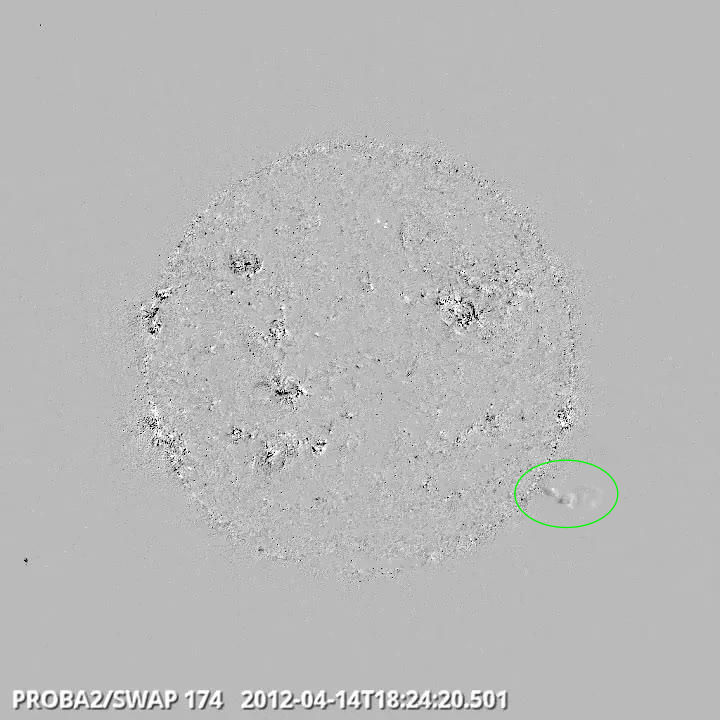


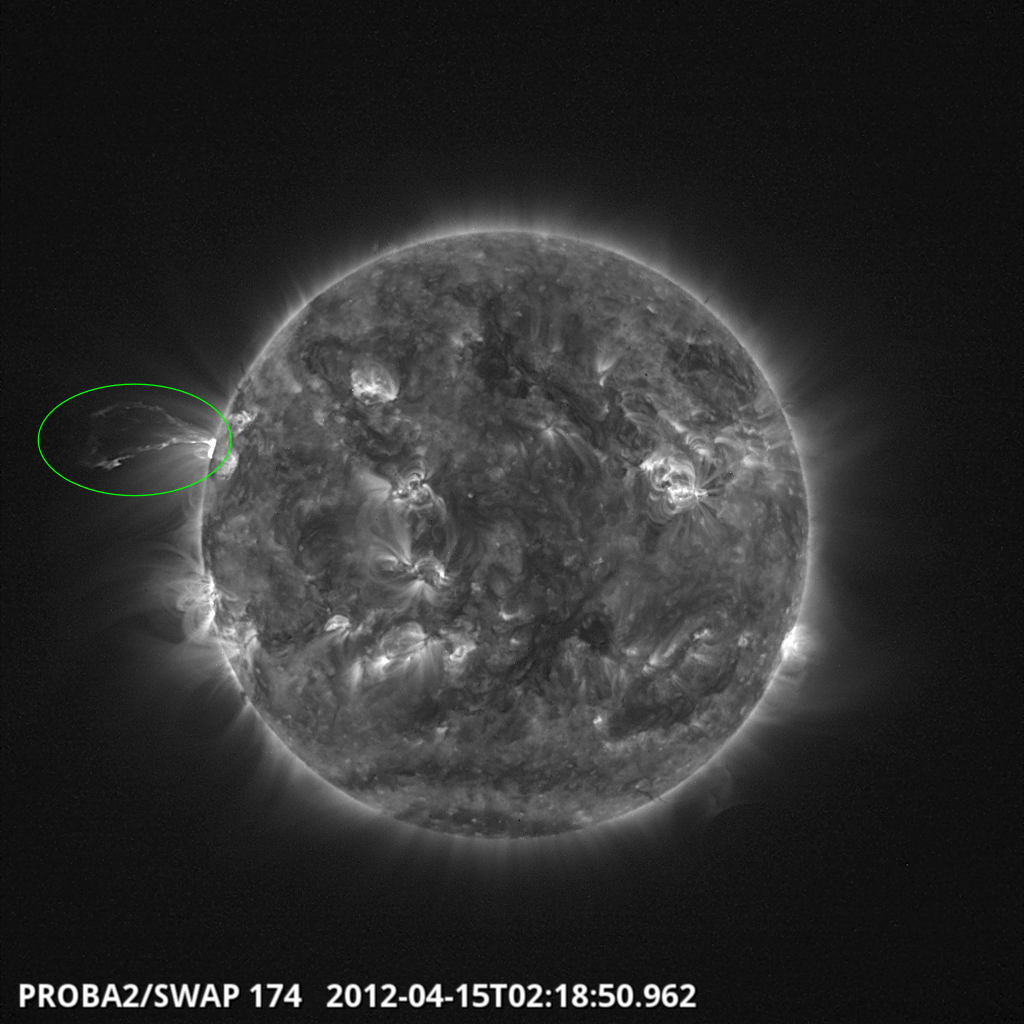
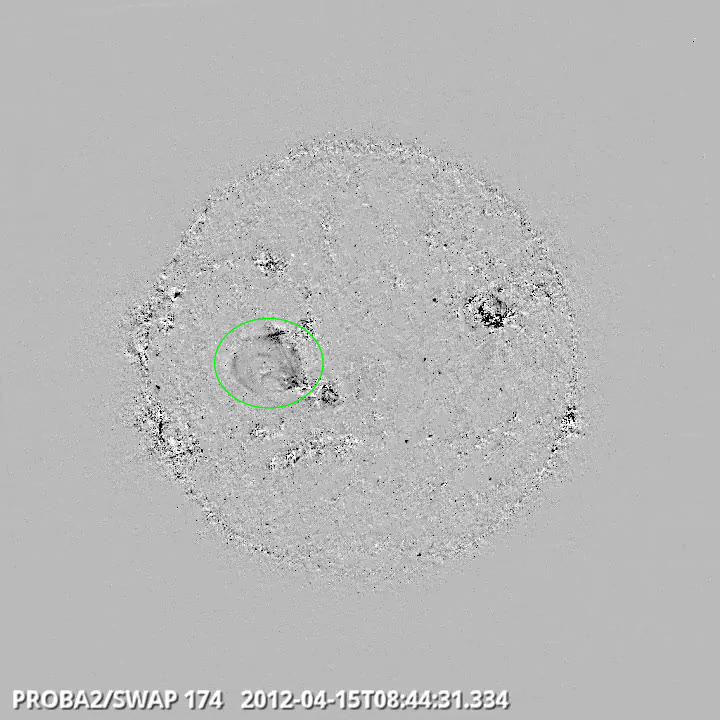
Start : 2012-04-22 - End : 2012-04-27
The EGU General Assembly 2012 will bring together geoscientists
from all over the world into one meeting covering all disciplines
of the Earth, Planetary and Space Sciences. Especially for young
scientists the EGU appeals to provide a forum to present their work
and discuss their ideas with experts in all fields of geosciences.
The EGU is looking forward to cordially welcome you in Vienna.
Space weather
related sessions:
Impact of solar and geomagnetic variabilities on the
Earth's lower,middle and upper atmospheres (Thierry Dudok de
Wit, Jean Lilensten, F.-J. Lübken, M. Kaufmann and P.
Preusse)
This interdisciplinary session focuses on the multiple impacts
of solar activity on climate variability. The session will address
both forcing mechanisms such as solar spectral irradiance,
geomagnetic perturbations and galactic cosmic rays, and the
response of the upper, middle and lower atmosphere. Special
attention will be payed to the solar flares and geomagnetic storms
as well as to the role of the long-term trends of the solar
activity, in particular, in global climate changes and modern
global warming. Papers involving the physical processes in the
ionosphere
and stratosphere
will be welcome in the first place.
The objective is to go beyond correlation analyses and gain a
better quantitative understanding of the different contributions of
solar variability to the terrestrial environment.
More information:
http://meetingorganizer.copernicus.org/EGU2012/provisionalprogramme/CL
Space Weather
and its Effects on Terrestrial and
Geo
-Space Environments: Science and
Applications (Viviane Pierrard (BIRA-IASB, Belgium), Hanna
Rothkaehl (Space Research Centre PAS, Poland), Norma Crosby
(BIRA-IASB, Belgium)
This session gathers together scientists with expertise in
various fields of solar-terrestrial physics that deal with the
effects of space phenomena on different levels of geo
-space. Effects range from those
observed on spacecraft related activities all the way down to
Earth, including technological systems, human health and the
Earth's climate. We welcome contributions (theoretical and
observational) as well as applied (effects on terrestrial and geo
-space environments), on all
aspects of space weather
. Contributions related to the ESA
Space Situational Awareness (SSA)
programme, or the EU FP7 programme, are very welcome. We look
forward to a dynamic and interdisciplinary session.
Website:
http://meetings.copernicus.org/egu2012/
Start : 2012-04-24 - End : 2012-04-27
Space Weather
Workshop is an annual conference
that brings industry, academia, and government agencies together in
a lively dialog about space weather
. What began in 1996 as a
conference for the space weather
user community, Space Weather
Workshop has evolved into the
Nation’s leading conference on all issues
relating to space weather
.
The conference addresses the remarkably diverse impacts of space
weather
on today’s
technology. The program highlights space weather
impacts in several areas, including
communications, navigations, spacecraft operations, aviation, and
electric power. The presentations and discussions at the Space
Weather
Workshop also focus on identifying
the highest priority needs for operational services that can guide
future research and identifying new high-value capabilities that
can be transitioned into operations. The conference fosters
communication among researchers, space weather
service providers, and users of
space weather
services.
Researchers have the opportunity to discuss relevant research in
many areas of the space environment. Recent progress in large-scale
modeling efforts will be featured; while new developments in
Sun-to-Earth coupled modeling systems will also be a highlight.
Website:
http://www.swpc.noaa.gov/sww/
Start : 2012-04-30 - End : 2012-05-04
As the impact of space weather
and climate on daily life is
becoming more important, it is timely to discuss the latest reseach
on the solar origin of these phenomena. Recent advances in
helioseismology have demonstrated that subsurface dynamics are
closely associated with aspects of solar activity from the
long-term timing of the solar cycle to the short-term eruption of
solar flares. The advent of synoptic vector magnetic field
measurements is opening up a new path for research on active
regions, flares and CME
's. Coronal magnetic field
measurements should become available in the next 5-10 years,
supplying another physical constrain on space weather
events.
Website:
http://www.nso.edu/general/workshops/2012/
Start : 2012-05-09 - End : 2012-05-11
The workshop on 'Advances on Space Radiation and Plasma
Environment Monitoring, Data
Analysis Methods and Flight Opportunities Workshop' is the forth of
a series of workshops proposed under the auspices of the Space
Environments and Effects Network of Technical Competences
established to further cooperation in Europe.
The number of flying or ready to fly European radiation and
plasma
instruments has increased
significantly since the last SEENoTC workshop on the subject in
2008 and a round-table at CNES in 2009. Research programmes have
also made good progresses in investigating innovative technologies
and new concepts designs which will allow a substantial reduction
of mass, power and data rate budgets compared to traditional
instrumentation, whilst providing equivalent or higher detection
efficiency. With many future missions in Navigation,
Telecommunications, Exploration, Science, GMES domains flying in
severe radiation environments and carrying highly sensitive
components and systems, the need for such radiation instrumentation
is increasing. Accurate measurements of the Space Environment plays
also a crucial role in improvement of radiation enviroment models
and the development of the space weather
services required by the Space
Situational Awareness programme.
The intention of this workshop is to provide a venue for
discussing the latest developments on space plasma
and radiation environments and
effects instrumentation, to examine possible flight opportunities
for such instruments, and to establish the necessary technical and
management steps necessary to ensure collaboration on future data
analyses, databases, data sharing, and lessons learned from flight
experience. It will also allow further discussion and capture of
explicit experiment needs and further the harmonization of
cooperation on instrument development, flight plans and data
exploitation.
Website:
http://www.congrexprojects.com/12C16
Start : 2012-05-20 - End : 2012-05-20
For more information:
http://eclipse.gsfc.nasa.gov/SEgoogle/SEgoogle2001.html
Start : 2012-05-20 - End : 2012-05-25
Helioseismology and asteroseismology are the only means to
investigate the interior of the Sun and stars. They are crucial for
understanding the structure and evolution of stars, which produce
all chemical elements in the universe heavier than helium, and
which host and influence planets which may carry life.
Understanding the physics of the Sun's interior is essential
for understanding the solar dynamo and consequently for predicting
solar magnetic activity, which has a severe impact on the operation
of space missions. Understanding the interior of the stars is
essential for understanding those astronomical objects that host
and influence planets. With the suite of the latest instruments and
missions, e.g. BiSON, GONG, SOHO
, SDO, Hinode and Picard for solar
exploration and MOST, CoRoT, Kepler, BRITE, SONG for stellar and
exoplanetary research, the precision on the seismically determined
quantities, e.g. flows in the solar interior or the ages and radii
of stars will be greatly improved. This will allow creating new
knowledge in solar physics and astrophysics and therefore makes the
proposed conference particularly timely.
Website:
http://www.esf.org/index.php?id=9140
Start : 2012-05-21 - End : 2012-05-23
The purpose of this workshop is to foster the development of
tools to interpret current and future measurements of coronal
magnetic fields in order to improve our understanding of the Sun
and the sources of Space Weather
. This is motivated by the
anticipated rapid growth over the next decade in our remote sensing
capabilities of the coronal plasma
. These new capabilities can only
be exploited with improvements in our ability to model the
polarized radiative transfer through the coronal plasma
and by coupling information on the
coronal magnetic field and plasma
conditions with models extending to
the near Earth environment.
This workshop will include a wide variety of subjects including,
but not limited to, instrumentation, the interpretation of
polarimetric signals in EUV and UV emission lines, techniques to
mitigate the effects of line-of-sight integration effects of the
optically thin corona such as tomographic inversions and forward
modeling, models of the polarized radiative transfer at radio
wavelengths, extrapolation and MHD modeling of coronal magnetic
fields, as well as discussions on how to move forward with coupling
these inferences of the coronal plasma
with models of heliospheric
structure and Space Weather
prediction.
Website:
http://www.hao.ucar.edu/CoronalMagnetismWorkshop/index.php
Start : 2012-05-31 - End : 2012-06-07
The 2012 Heliophysics Summer School will focus on the science
underlying current and future heliophysical missions, including but
not limited to MMS, Themis
, RBSP, IRIS, SDO, and Solar Probe
Plus. After providing students with broad overviews of the solar
atmosphere, the solar wind
, the Earth’s
magnetosphere
, and ionosphere
, the course will cover the basic
concepts and unanswered questions pertaining to magnetic
reconnection, shocks, plasma
instabilities, turbulence, and
heating, and the manner in which these concepts and questions
affect our understanding of phenomena such as substorms, radiation
belt and chromospheric dynamics, solar wind
turbulence and particle heating,
and heliospheric shocks.
Link:
http://www.vsp.ucar.edu/Heliophysics/summer-about-over.shtml
Start : 2012-06-04 - End : 2012-07-27
The Los Alamos National Laboratory established a summer school
in 2011 dedicated to space weather
, space science and applications.
Every year we solicit applications for the Los Alamos Space Weather
Summer School. This summer school
is sponsored by IGPP (Institute of Geophysics and Planetary
Physics) and PADSTE (Principal Associate Directorate for Science,
Technology and Engineering), and PADGS (Principal Associate
Directorate for Global Security) and has been established to bring
together top space science students with internationally recognized
researchers at LANL.
Website:
http://www.swx-school.lanl.gov/
Start : 2012-06-04 - End : 2012-06-09
The Space Weather
Integrated Forecasting Framework
network (http://www.swiff.eu) organizes in June 2012 the
“First European School on Fundamental processes
in space weather
, a challenge in numerical
modelingâ€. The School will focus on the theoretical
study of Space plasmas, in particular on those systems where a
continuous energy injection flow leads to a self-consistent
coupling of the large scale, low frequency motions with the small
scale, high frequency fluctuations including kinetic effects.
Progress in this field heavily relies on numerical simulations
that, as a matter of fact, are nowadays more similar to laboratory
experiments than to theoretical exercises. This is true in terms of
planning efforts in the preparatory phase, of manpower required, of
data analysis and cost. The understanding of these processes
represents a fundamental step for the future of Space Weather
models.
Website:
http://www.df.unipi.it/~califano/SWIFF_School/EU_School_on_Space_Weather_fundamental_plasma_processes.html
Start : 2012-06-04 - End : 2012-06-08
During the last thirty years there has been steady progress in
our understanding of the influence that space weather
has on the state of human health
both in Space and at Earth. This development is mainly based on
research conducted on humans onboard space stations and
spacecrafts, as well as on ground based observations and
experimental studies simulating conditions in space. This
interdisciplinary field of research requires a wide exchange of
expertise in various topics. Only with a global approach it will be
possible to establish a mutual understanding, in regard to defining
the current state of this research problem as well as identifying
what should be pursued in future research activities.
Website:
http://swh2012.cosmos.ru/
Start : 2012-06-06 - End : 2012-06-10
We announce the 'Second Remote Sensing of the Inner Heliosphere
Workshop' to be hosted by
Aberystwyth University and held in Aberystwyth, Wales, UK, 06-10
June 2011. The workshop aims to gather experts from the various
fields of remote-sensing observations of the inner heliosphere
, including white-light, EUV, and
radio observation, together with modellers in order to tackle key
outstanding science issues, establish closer working relations, and
devise the best ways to move the field forward. In addition, the
science learned from remote-sensing observations is key to
improving our capabilities of space weather
forecasting. The workshop also aims
to look at ways in which we can more easily and efficiently share
and access the various types of data between individual groups and
sub-communities, ways in which we model the inner heliosphere
looking at the advantages and
disadvantages of the available modelling, updates on present and
future remote-sensing capabilities - including those on the STEREO
/SDO/Solar Orbiter/Solar Probe+
Missions, and progress on use of the LOw Frequency ARray (LOFAR)
and Murchison Widefield Array (MWA) radio arrays - pathfinders for
the Square Kilometre Array (SKA) - linking remote-sensing
observations of the inner heliosphere
with those closer-in to the Sun as
well as with in-situ measurements, and investigating further the
ways in which these data sets all complement each other and are
necessary to gain knowledge and understanding of the fundamental
physical processes that occur within the inner heliosphere
.
Website:
http://heliosphere2011.dph.aber.ac.uk/
Start : 2012-06-17 - End : 2012-06-22
The Thirteenth International Solar Wind
Conference, organized by the
University of Alabama in Huntsville's Center of Space Plasma
and Aeronomic Research (CSPAR) and
the the University of California, Berkeley's Space Sciences
Laboratory, will take place at Sheraton Keauhou Resort on Big
Island, Hawaii, USA, from 17 to 22 June 2012. Please note that
scientific sessions will start on Monday 18 June.
The conference will conform to the traditional solar wind
themes, addressing the current
state of knowledge in the relevant fields of solar and heliospheric
physics. In particular, the conference will focus on the physics
ofthe corona, the origin and acceleration of the solar wind
, its dynamical interactions
throughout the heliosphere
and the interstellar medium and its
boundaries. The program will be composed of both invited lectures
and contributed talks and posters.
Website: http://www.sw13.org/
Start : 2012-06-25 - End : 2012-06-29
SHINE stands for Solar Heliospheric and INterplanetary
Environment. It is an affiliation of researchers within the solar,
interplanetary, and heliospheric communities, dedicated to
promoting an enhanced understanding of the processes by which
energy in the form of magnetic fields and particles are produced by
the Sun and/or accelerated in interplanetary space and on the
mechanisms by which these fields and particles are transported to
the Earth through the inner heliosphere
.
SHINE research focuses in particular upon the connection between
events and phenomena on the Sun and their relation to solar wind
structures in the inner heliosphere
. The goal of SHINE activities is
to enrich and strengthen both physical understanding and predictive
capabilities for these phenomena.
Website:
http://shinecon.org/Current%20Meeting.htm
Start : 2012-06-25 - End : 2012-06-28
Toulouse will host the most important players in the global
aerospace industry, particularly those focusing on space
applications. It will provide the opportunity to meet with more
than 1000 experts, service providers, clients, users, researchers
and students from all over the world.
Website:
http://www.toulousespaceshow.eu/tss12/en/
Start : 2012-07-01 - End : 2012-07-06
We have the pleasure to invite you in July 2012 to attend the
European Week of Astronomy and Space Science, the now classical
Ewass meeting, formely known as Jenam. In 2012, the meeting will
take place in Rome, Italy, at the Pontificia UniversitÃ
Lateranense.
Website:
http://www.ifsi-roma.inaf.it/ewass2012/
Start : 2012-07-03 - End : 2012-07-19
The Sun is our closest and most well studied celestial object.
From the beginnings of human civilizations, the Sun has played a
major role in their development, and in the rituals and customs
that can still be perceived in the modern world. Unprecedented
advances and new missions have revealed the real complexity of the
Sun. New missions like SDO, SolarProbe Plus and other satellite
missions (RHESSI, SOHO
, TRACE
, YOHKOH
, etc.) provide information that
may help to unveil the secrets of our star
. The Observatorio Astronomico
Nacional and the Universidal Nacional de Colombia organises an
International Summer School in Solar Physics, with the purpose of
promoting the solar research in Colombia and help in the personal
development of postgraduate students and young postdocs in this
area from other countries.
The International Summer School is intended to provide an
advanced training in the field of solar physics to last year
ungraduate students who are willing to write their final work in
any area of solar physics, postgraduate students, and young
post-docs having already some initial work in the fields of solar
physics.
Website:
http://www.observatorio.unal.edu.co/eventos/solarschool/
Start : 2012-07-03 - End : 2012-07-19
Start : 2012-07-04 - End : 2012-07-07
The Sun is the most important astronomical object for humankind
with solar activity having a direct impact on Earth. From a
fundamental point of view the Sun offers an exceptional physics
laboratory where the interactions of the astrophysical plasma
and the magnetic field can be
studied in detail.
The BUKS workshops on MHD waves and oscillations of the solar
atmosphere is organised by the following research groups from
Belgium, Spain and the UK:
* The Centre for Plasma
Astrophysics, Katholieke
Universiteit Leuven, Belgium
* The Solar Physics & Space Plasma
Research Centre, University of
Sheffield, UK
* The Solar & Magnetospheric Theory Group, University of
St Andrews, UK
* The Centre for Fusion, Space & Astrophysics,
University of Warwick, UK
* The Solar Physics Group, Universitat de les Illes Balears,
Spain
* The Astrophysics Research Centre, Queen's University
Belfast, UK
BUKS2012 will also honour the contributions of Prof Marcel
Goossens to the field of MHD waves and offer an opportunity to
celebrate his 65th birthday.
Website:
https://habu.pst.qub.ac.uk/groups/buks2012/
Start : 2012-07-08 - End : 2012-07-11
The 23rd Annual NASA
Space Radiation
Investigators’ Workshop will be held July
8–12, 2012, at the Washington Duke Inn, Durham,
North Carolina. The purpose of this workshop is to provide an
opportunity for active researchers in the NASA
Space Radiation Program to share
the results of their work and to explore new directions for
research that may benefit the NASA
program. The workshop format will
include plenary sessions, poster sessions, and a poster contest to
recognize and honor student investigators. In addition, there will
be special sessions on space physics and technology allowing
opportunities for a comprehensive discussion on
NASA’s overall space radiation protection
goals.
Principal investigators receiving NASA
funds (including those from the
NASA
/DOE joint program and the NSBRI)
are required to attend; principal investigators funded by the
Department of Energy are strongly encouraged to attend. Although
attendance at the workshop is by invitation only, other scientists
with a legitimate interest in space radiation research are also
welcome. If you wish to attend, please send your requests directly
to
. Requests should be accompanied by an explanation of
your relationship to the Space Radiation Program and the type of
contribution you wish to make.
Website:
http://www.dsls.usra.edu/meetings/radiation2012/
Start : 2012-07-11 - End : 2012-07-15
From 11th-15th of July 2012 international researchers, policy
makers, business leaders and global media will gather in the
Convention Centre in Dublin, Ireland to take part in the
Euroscience Open Forum (ESOF), 2012. A science conference like no
other, ESOF 2012 is unique in representing the largest convergence
of the Sciences, Humanities and Culture in Europe in 2012. Some of
the keynote speakers at ESOF 2012 will include Craig Venter,
Rolf-Dieter Heuer, Charles Bolden, Mary Robinson, and Bob
Geldof.
Website: http://www.esof2012.org/
Start : 2012-07-14 - End : 2012-07-22
The 39th COSPAR Scientific Assembly will be held at the Global
Education Centre, 2 Infosys Training Centre Mysore, Karnataka India
from 14 - 22 July 2012. This Assembly is open to all bona fide
scientists.
Website:
http://www.cospar-assembly.org/
Start : 2012-07-16 - End : 2012-07-27
The CISM Space Weather
Summer School is a 2-week intensive
program targeted to first-year graduate students but also attended
by undergraduates and space weather
professionals. The daily schedule
includes morning lectures, followed by afternoon laboratory
sessions where students further explore the day's topics using
CISM model simulations, observational data, and sophisticated
visualization tools. CISM is making the laboratory materials
publicly available for use by others, for example to supplement
lecture courses or for student independent study. The deadline for
applications is May 1.
Website:
http://www.bu.edu/cism/SummerSchool/overview.html
Start : 2012-07-23 - End : 2012-07-27
The Department of Astronomy and Geodynamics of the University of
Warmia and Mazury (UWM) is hosting the 2012 IGS Workshop.
This workshop will be composed or plenary sessions with invited
oral presentations, and afternoon sessions composed of poster
sessions and IGS Working Group splinter meetings. For this workshop
we are soliciting abstracts for the poster sessions.
The key dates for this workshop are as follows:
* Poster Abstract Submissions: March 25 - April 30, 2012.
* Registration: March 25- May 28, 2012.
* Hotel Reservations: March 25- May 28, 2012.
* Workshop: July 23 - July 27, 2012.
Website:
http://www.uwm.edu.pl/kaig/igs_workshop_2012/
Start : 2012-08-06 - End : 2012-08-10
The IRC's International Radiation Symposium 2012 provides a
forum for the scientific community to exchange recent results and
evolving ideas relevant to many areas of atmospheric radiation.
Quadrennially convened, the IRS assembles a global network of
scientists and students engaged in studies pertaining to the
Earth-atmosphere-Sun system, and encourages international
cooperation in radiation research crucial to understanding and
predicting Earth's dynamic climate and habitability. The IRC
invites you to Berlin and welcomes your participation in this
endeavor.
Website: http://irs2012.org/
Start : 2012-08-13 - End : 2012-08-17
An international body established since 2003, the Asia Oceania
Geosciences Society (AOGS) aims to promote geosciences and advance
its applications for the benefit of humanity in Asia and
Oceania.
Sessions:
* Atmospheric Sciences
* Biogeosciences
* Hydrological Sciences
* Ocean Sciences
* Planetary Sciences
* Solar & Terrestrial Sciences
* Solid Earth Sciences
* Interdisciplinary Working Groups
Website:
http://www.asiaoceania.org/aogs2012/public.asp?page=home.htm
Start : 2012-08-13 - End : 2012-08-16
You will have a noticed the slight re-branding of these
workshops from ‘Image’ to
‘Information’ processing. We
think it is time to expand the attention of these workshops to
discuss more generally how information about the Sun can be
derived, stored, shared, transformed and analyzed using appropriate
techniques from many other disciplines. We will still be covering
image processing and computer vision techniques applied to solar
physics, but we will also be including other topics such as machine
learning, data mining and new computing strategies. The re-branding
simply acknowledges and makes explicit what the community has been
doing to determine the physics of the Sun.
Link: http://www.sipwork.org/
Start : 2012-08-14 - End : 2012-08-17
There will be 7 sessions, with 2 invited speakers per session.
The following speakers have been invited to Hinode-6:
Website:
http://www-solar.mcs.st-and.ac.uk/~hinode6/Hinode-6/Welcome.html
Start : 2012-08-20 - End : 2012-08-31
In August 2012 China will for the first time host the General
Assembly of the International Astronomical Union in Beijing. This
triennial gathering of astronomers from around the world to discuss
and debate the most recent discoveries about the universe is an
important part of the vitality of our science. Astrophysics remains
one of the most exciting areas of human endeavor, and the venue of
the Beijing GA will be equally impressive: the new China National
Convention Center that is housed in the Olympic Park in a
beautiful, spacious building and area that is full of amenities for
conference participants and visitors.
The contributions of Chinese astronomy to human knowledge and
our understanding of the cosmos have been of historical
significance, from the earliest to modern times. GA participants
will have an opportunity to experience the wide range of
astronomical activities now taking place in China that include new
projects, facilities, and institutes. They will also report on, and
hear, the latest research results from every field of astronomy. An
exciting scientific programme is being developed that will hold the
interest of everyone. I am pleased to welcome all Union members and
invited guests to join us in Beijing for what will be a memorable
General Assembly.
Website:
http://www.astronomy2012.org
Start : 2012-09-20 - End : 2012-09-23
Every year, the International Meteor
Organization (IMO) organizes the
International Meteor
Conference (IMC). This conference
deals with all aspects of meteor
observation as well as the
underlying physics and is aimed at both amateurs and
professionals.
The International Meteor
Organization (IMO) will hold the
31st annual International Meteor
Conference (IMC) on La Palma,
Canary Islands, Spain, from 20 till 23 September, 2012. The
conference will be organized by the Astro Travels agency in
collaboration with the Cabildo of La Palma island authority which
will sponsor this event.
Website:
http://www.imo.net/imc2012/
Start : 2012-09-24 - End : 2012-09-28
The 21st European Conference on RADIATION AND ITS EFFECTS ON
COMPONENTS AND SYSTEMS will be held in Biarritz, France, on
September 24-28, 2012.
The aim of RADECS conferences is to provide an annual European
forum for the presentation and discussion of the latest advances in
the field of radiation effects on electronic and photonic
materials, devices, circuits, sensors, and systems. The scope of
the conference encompasses technological processes and design
techniques for producing radiation tolerant systems for space,
aeronautical or terrestrial applications, as well as relevant
methodologies for their characterization and qualification. The
conference features a technical program, an Industrial Exhibit, and
one day meeting on ground effects offered on September 24
(RADGROUND). The technical program includes oral and
postersessions.
The areas of interest for contributions to be submitted to
RADECS 2012 include, but are not limited to:
* Basic mechanisms of radiation effects in electronic and
optical materials
* Space, atmospheric and terrestrial environments
* Radiation effects on electronic and photonic devices, circuits
and systems
* Radiation effects on sensors and emerging devices
* Technology and design hardening
* Radiation hardness assurance
* Irradiation facilities and testing
Website: http://radecs2012.org
Start : 2012-10-01 - End : 2012-10-05
At the forthcoming 63rd International Astronautical Congress in
Naples a special session on the theme 'Effects of Space Weather
on GEO
Satellites' will be held as part of
the 25th Symposium on Space Policy, Regulations and Economics.
This session will discuss case histories and mechanisms of
effects of space weather
on GEO
satellites, models for prediction,
and mitigation approaches. We would like to invite you to consider
submitting abstracts for this session.
The call for papers can be found at
The
deadline for abstract submission is 29 February 2012.
http://www.iafastro.org/docs/2012/iac/IAC2012_CallForPapers.
Website: http://www.iac2012.org/
Start : 2012-10-22 - End : 2012-10-24
2012 – 2013 is expected to be years with high
solar activity. This can trigger larger solar storms which can
generate geomagnetic induced currents (GIC
) on the earth. GIC
can affect the normal operation of
specific industrial operations and critical infrastructure (e.g
power grids, telecom, navigation systems, etc).
During space weather
events, like solar storms, electric
currents in the magnetosphere
and ionosphere
experience large variations, which
manifest also in the earth's magnetic field. These variations
induce currents (GIC
) in conductors operated on the
surface of the earth. Electric transmission grids and buried
pipelines are common examples of such conductor systems. GIC
can cause problems, such as
increased corrosion of pipeline steel and may disturb and possible
damaged high-voltage power transformers and it can also have
damaging effects on communication systems, navigation systems and
oil and gas operations.
Vulnerable industries are the oil and gas industry, railways,
telecommunication industry, navigation industry and not at least
the society, which is very vulnerable concerning short or long term
interruption of critical infrastructure.
The conference will focus on increasing the general knowledge of
solar storms, space weather
and GIC
and the possible consequences for
different industries and critical infrastructure, and look into
reasonable means of protection, and consider possible early warning
solutions.
Website:
http://www.tiems.info/about-tiems/oslo-conference-2012.html
Start : 2012-11-05 - End : 2012-11-09
We are pleased to announce that the Ninth European Space Weather
Week will take place at the
Académie Royale de Belgique, Brussels, Belgium between 5
and 9 November 2012.
This meeting is being jointly organised by the Solar-Terrestrial
Centre of Excellence (STCE), ESA
, the SWWT and the COST ES0803
communities. The local organisation is done by the STCE. This event
will continue to build on the advances made during the first eight
European Space Weather
Weeks held between 2004 and
2011.
Website:
http://www.sidc.be/esww9/
Start : 2012-11-06 - End : 2012-11-09
The International Symposium on Solar-Terrestrial Physics will be
held during November 6 - 9, 2012 at the Indian Institute of
Science, Education and Research, Pune, India. This meeting under
the aegis of the SCOSTEP is expected to draw leading scientists
from around the world in the increasingly important,
interdisciplinary fields of Solar activity and its impact on
geospace and life on the Earth. With major observational solar
facilities being planned in India, this meeting is especially
pertinent in the Indian context.
The meeting is expected to involve professional scientists as
well as graduate students, and will have a mixture of invited and
contributed talks and posters. There will also be a one-day
tutorial for the benefit of young people beginning work in the
field of solar-terrestrial physics.
Website:
http://www.iiserpune.ac.in/~isstp2012/
Start : 2012-11-12 - End : 2012-11-16
As we emerge from one of the deepest and longest solar minima on
record, with a new and powerful eye on the Sun -SDO- we invite all
those with an interest is solar activity to gather in beautiful
Palm Cove, Australia to review and assess our current knowledge and
understanding of our magnetic star
, and to experience the awe and
wonder of a total solar eclipse on November 14, 2012.
Website:
http://moca.monash.edu/eclipse/
Start : 2012-11-13 - End : 2012-11-13
For more information:
http://eclipse.gsfc.nasa.gov/OH/OH2012.html#SE2012Nov13T
Start : 2012-11-15 - End : 2012-11-16
The European Commission will organise the 'Let's embrace
space - FP7 Space Conference 2012', in cooperation with the Cypriot
EU Presidency, on 15 and 16 November 2012 in Larnaca, Cyprus.
This scientific conference will present the current status and
results of the 3rd call of FP7 space research, and also discuss
future options for European research in the space field. In doing
so, the conference will aim at demonstrating the evolution and use
of space tools for a sustainable economic and environmental
development in a European and global context.
Website:
http://www.fp7-space.eu/news-119.phtm
Start : 2012-11-20 - End : 2012-11-23
Nobeyama Radioheliograph (NoRH) has been observing the Sun since
1992. This year is the 20th year of science operation. Instruments
are still in good shape and producing images of the Sun every day
with the same quality as the beginning. Due to the nature of the
instrument and long and uniform observations, data can be used for
wide variety of solar physics and also for solar terrestrial
physics. To mark the 20 years of operation, we will organize a
symposium to summarize what has been done with NoRH and to discuss
what we should do in the future. Papers to be presented in the
meeting will be mainly concerned with the results from NoRH and
future plans.
Website:
http://st4a.stelab.nagoya-u.ac.jp/SPRO2012/
Start : 2012-11-30 - End : 2012-12-05
The overarching objective of the conference is to examine the
connections amongst the phenomena that lead to solar eruptive
events. The current state of themes includes:
* Measuring the Coronal Magnetic Field;
* Connections to, and Reactions of, the Large-Scale Corona;
* Large-scale Magnetic Connectivity of Active Regions;
* Transfer of Energy to, and Storage of Energy in, the
Corona;
* The High-Energy Particle - Flare - CME
connection.
Working groups will address topics such as:
* Energy Transfer throughout a Solar Eruptive Event;
* Global Energetics of an Ensemble of Events;
* Coronal Influences to the Lower Atmosphere;
* CME
Initiation and Type II Bursts;
* The Release of Energetic Particles in the Low Corona;
* Flows vs. Waves;
* Microflares/Nanoflares.
Website:
http://hessi.ssl.berkeley.edu/petaluma/index.shtml
Start : 2013-01-13 - End : 2013-01-19
Information coming soon!
Website:
http://sd-www.jhuapl.edu/Aurora/ESSE/index.html
Start : 2013-03-10 - End : 2013-03-15
Spacecraft observations have established that all magnetized
planets in our solar system interact strongly with the solar wind
and possess well-developed
magnetotails. Magnetotails are the site for many dynamic processes
critical to the circulation of mass, energy and magnetic flux. The
great differences in solar wind
conditions, planetary rotation
rates, ionospheric conductivity, and physical dimensions from
Mercury’s small magnetosphere
to the giant magnetospheres of
Jupiter and Saturn provide an outstanding opportunity to extend our
understanding of the influence of these factors. Therefore, this
Chapman conference will provide a forum in which various
communities can come together and discuss recent achievements of
observational, theoretical, and modeling studies with the objective
to develop a deeper understanding of fundamental properties and
processes of planetary magnetotails through a comparative
examination.
Start : 2013-05-10 - End : 2013-05-10
For more information:
http://eclipse.gsfc.nasa.gov/SEplot/SEplot2001/SE2013May10A.GIF
Start : 2013-11-03 - End : 2013-11-03
For more information:
http://eclipse.gsfc.nasa.gov/SEplot/SEplot2001/SE2013Nov03H.GIF
This presentation gives an overview of the charged particle radiation environment and its main effects on spacecraft material.
http://www.spaceweather.eu/en/repository/show?id=178